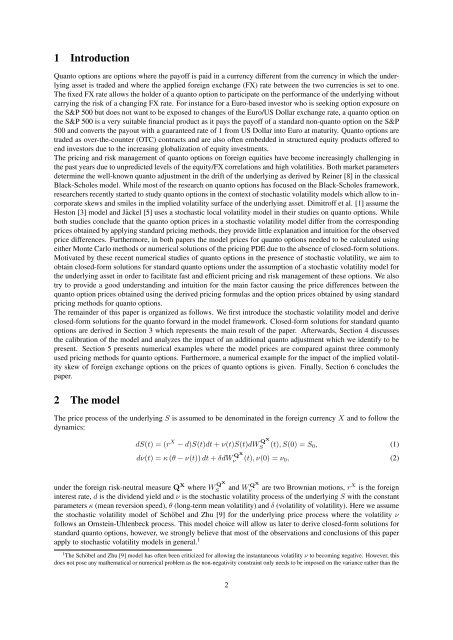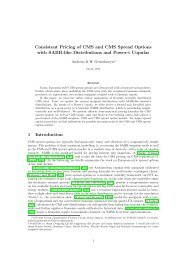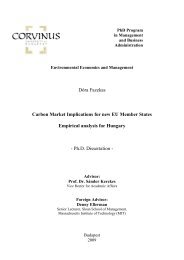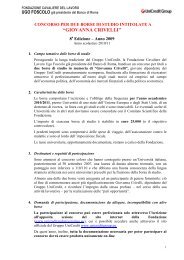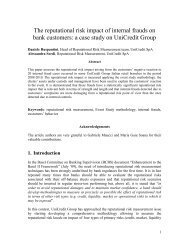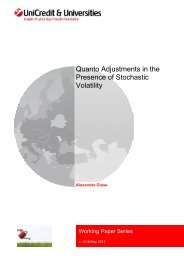Quanto Adjustments in the Presence of Stochastic Volatility
Quanto Adjustments in the Presence of Stochastic Volatility
Quanto Adjustments in the Presence of Stochastic Volatility
You also want an ePaper? Increase the reach of your titles
YUMPU automatically turns print PDFs into web optimized ePapers that Google loves.
1 Introduction<br />
<strong>Quanto</strong> options are options where <strong>the</strong> pay<strong>of</strong>f is paid <strong>in</strong> a currency different from <strong>the</strong> currency <strong>in</strong> which <strong>the</strong> underly<strong>in</strong>g<br />
asset is traded and where <strong>the</strong> applied foreign exchange (FX) rate between <strong>the</strong> two currencies is set to one.<br />
The fixed FX rate allows <strong>the</strong> holder <strong>of</strong> a quanto option to participate on <strong>the</strong> performance <strong>of</strong> <strong>the</strong> underly<strong>in</strong>g without<br />
carry<strong>in</strong>g <strong>the</strong> risk <strong>of</strong> a chang<strong>in</strong>g FX rate. For <strong>in</strong>stance for a Euro-based <strong>in</strong>vestor who is seek<strong>in</strong>g option exposure on<br />
<strong>the</strong> S&P 500 but does not want to be exposed to changes <strong>of</strong> <strong>the</strong> Euro/US Dollar exchange rate, a quanto option on<br />
<strong>the</strong> S&P 500 is a very suitable f<strong>in</strong>ancial product as it pays <strong>the</strong> pay<strong>of</strong>f <strong>of</strong> a standard non-quanto option on <strong>the</strong> S&P<br />
500 and converts <strong>the</strong> payout with a guaranteed rate <strong>of</strong> 1 from US Dollar <strong>in</strong>to Euro at maturity. <strong>Quanto</strong> options are<br />
traded as over-<strong>the</strong>-counter (OTC) contracts and are also <strong>of</strong>ten embedded <strong>in</strong> structured equity products <strong>of</strong>fered to<br />
end <strong>in</strong>vestors due to <strong>the</strong> <strong>in</strong>creas<strong>in</strong>g globalization <strong>of</strong> equity <strong>in</strong>vestments.<br />
The pric<strong>in</strong>g and risk management <strong>of</strong> quanto options on foreign equities have become <strong>in</strong>creas<strong>in</strong>gly challeng<strong>in</strong>g <strong>in</strong><br />
<strong>the</strong> past years due to unpredicted levels <strong>of</strong> <strong>the</strong> equity/FX correlations and high volatilities. Both market parameters<br />
determ<strong>in</strong>e <strong>the</strong> well-known quanto adjustment <strong>in</strong> <strong>the</strong> drift <strong>of</strong> <strong>the</strong> underly<strong>in</strong>g as derived by Re<strong>in</strong>er [8] <strong>in</strong> <strong>the</strong> classical<br />
Black-Scholes model. While most <strong>of</strong> <strong>the</strong> research on quanto options has focused on <strong>the</strong> Black-Scholes framework,<br />
researchers recently started to study quanto options <strong>in</strong> <strong>the</strong> context <strong>of</strong> stochastic volatility models which allow to <strong>in</strong>corporate<br />
skews and smiles <strong>in</strong> <strong>the</strong> implied volatility surface <strong>of</strong> <strong>the</strong> underly<strong>in</strong>g asset. Dimitr<strong>of</strong>f et al. [1] assume <strong>the</strong><br />
Heston [3] model and Jäckel [5] uses a stochastic local volatility model <strong>in</strong> <strong>the</strong>ir studies on quanto options. While<br />
both studies conclude that <strong>the</strong> quanto option prices <strong>in</strong> a stochastic volatility model differ from <strong>the</strong> correspond<strong>in</strong>g<br />
prices obta<strong>in</strong>ed by apply<strong>in</strong>g standard pric<strong>in</strong>g methods, <strong>the</strong>y provide little explanation and <strong>in</strong>tuition for <strong>the</strong> observed<br />
price differences. Fur<strong>the</strong>rmore, <strong>in</strong> both papers <strong>the</strong> model prices for quanto options needed to be calculated us<strong>in</strong>g<br />
ei<strong>the</strong>r Monte Carlo methods or numerical solutions <strong>of</strong> <strong>the</strong> pric<strong>in</strong>g PDE due to <strong>the</strong> absence <strong>of</strong> closed-form solutions.<br />
Motivated by <strong>the</strong>se recent numerical studies <strong>of</strong> quanto options <strong>in</strong> <strong>the</strong> presence <strong>of</strong> stochastic volatility, we aim to<br />
obta<strong>in</strong> closed-form solutions for standard quanto options under <strong>the</strong> assumption <strong>of</strong> a stochastic volatility model for<br />
<strong>the</strong> underly<strong>in</strong>g asset <strong>in</strong> order to facilitate fast and efficient pric<strong>in</strong>g and risk management <strong>of</strong> <strong>the</strong>se options. We also<br />
try to provide a good understand<strong>in</strong>g and <strong>in</strong>tuition for <strong>the</strong> ma<strong>in</strong> factor caus<strong>in</strong>g <strong>the</strong> price differences between <strong>the</strong><br />
quanto option prices obta<strong>in</strong>ed us<strong>in</strong>g <strong>the</strong> derived pric<strong>in</strong>g formulas and <strong>the</strong> option prices obta<strong>in</strong>ed by us<strong>in</strong>g standard<br />
pric<strong>in</strong>g methods for quanto options.<br />
The rema<strong>in</strong>der <strong>of</strong> this paper is organized as follows. We first <strong>in</strong>troduce <strong>the</strong> stochastic volatility model and derive<br />
closed-form solutions for <strong>the</strong> quanto forward <strong>in</strong> <strong>the</strong> model framework. Closed-form solutions for standard quanto<br />
options are derived <strong>in</strong> Section 3 which represents <strong>the</strong> ma<strong>in</strong> result <strong>of</strong> <strong>the</strong> paper. Afterwards, Section 4 discusses<br />
<strong>the</strong> calibration <strong>of</strong> <strong>the</strong> model and analyzes <strong>the</strong> impact <strong>of</strong> an additional quanto adjustment which we identify to be<br />
present. Section 5 presents numerical examples where <strong>the</strong> model prices are compared aga<strong>in</strong>st three commonly<br />
used pric<strong>in</strong>g methods for quanto options. Fur<strong>the</strong>rmore, a numerical example for <strong>the</strong> impact <strong>of</strong> <strong>the</strong> implied volatility<br />
skew <strong>of</strong> foreign exchange options on <strong>the</strong> prices <strong>of</strong> quanto options is given. F<strong>in</strong>ally, Section 6 concludes <strong>the</strong><br />
paper.<br />
2 The model<br />
The price process <strong>of</strong> <strong>the</strong> underly<strong>in</strong>g S is assumed to be denom<strong>in</strong>ated <strong>in</strong> <strong>the</strong> foreign currency X and to follow <strong>the</strong><br />
dynamics:<br />
dS(t) = (r X − d)S(t)dt + ν(t)S(t)dW QX<br />
S (t), S(0) = S0, (1)<br />
dν(t) = κ (θ − ν(t)) dt + δdW QX<br />
ν (t), ν(0) = ν0, (2)<br />
under <strong>the</strong> foreign risk-neutral measure QX where W QX<br />
S and W QX<br />
ν are two Brownian motions, rX is <strong>the</strong> foreign<br />
<strong>in</strong>terest rate, d is <strong>the</strong> dividend yield and ν is <strong>the</strong> stochastic volatility process <strong>of</strong> <strong>the</strong> underly<strong>in</strong>g S with <strong>the</strong> constant<br />
parameters κ (mean reversion speed), θ (long-term mean volatility) and δ (volatility <strong>of</strong> volatility). Here we assume<br />
<strong>the</strong> stochastic volatility model <strong>of</strong> Schöbel and Zhu [9] for <strong>the</strong> underly<strong>in</strong>g price process where <strong>the</strong> volatility ν<br />
follows an Ornste<strong>in</strong>-Uhlenbeck process. This model choice will allow us later to derive closed-form solutions for<br />
standard quanto options, however, we strongly believe that most <strong>of</strong> <strong>the</strong> observations and conclusions <strong>of</strong> this paper<br />
apply to stochastic volatility models <strong>in</strong> general. 1<br />
1 The Schöbel and Zhu [9] model has <strong>of</strong>ten been criticized for allow<strong>in</strong>g <strong>the</strong> <strong>in</strong>stantaneous volatility ν to becom<strong>in</strong>g negative. However, this<br />
does not pose any ma<strong>the</strong>matical or numerical problem as <strong>the</strong> non-negativity constra<strong>in</strong>t only needs to be imposed on <strong>the</strong> variance ra<strong>the</strong>r than <strong>the</strong><br />
2


